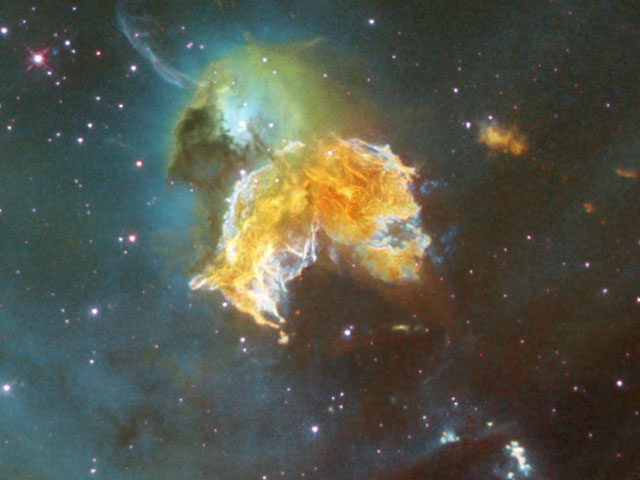
|
Credit & Copyright: Y.-H. Chu & R. M. Williams
(UIUC)
Explanation:
What has this supernova left behind?
As little as 2,000 years ago, light from a massive stellar explosion in the
Large
Magellanic Clouds (LMC) first reached planet Earth.
The LMC is a close galactic neighbor of our
Milky Way Galaxy
and the rampaging
explosion
front is now seen moving out - destroying or displacing
ambient gas clouds while leaving behind relatively dense
knots of gas and dust.
What remains is one of the largest
supernova remnants in the
LMC: N63A.
Many of the surviving dense
knots have been themselves compressed and may further
contract to form new stars.
Some of the resulting stars may then explode in a supernova,
continuing the cycle.
Pictured above is a close-up of one of the largest
remaining knots of dust and gas in
N63A
taken by the orbiting Hubble Space Telescope.
N63A spans over 25
light years and lies about 150,000 light years away
toward the southern
constellation
of Dorado.
|
January February March April May June July August September October November December |
| ||||||||||||||||||||||||||||||||||||||||||||||||
NASA Web Site Statements, Warnings, and Disclaimers
NASA Official: Jay Norris. Specific rights apply.
A service of: LHEA at NASA / GSFC
& Michigan Tech. U.
Based on Astronomy Picture
Of the Day
Publications with keywords: LMC - supernova remnant
Publications with words: LMC - supernova remnant
See also:
- APOD: 2026 January 7 Á Simeis 147: The Spaghetti Nebula Supernova Remnant
- APOD: 2025 October 26 Á Halloween and the Ghost Head Nebula
- APOD: 2025 October 1 Á NGC 6960: The Witchs Broom Nebula
- APOD: 2025 June 9 Á Between Scylla and Charybdis: A Double Cosmic Discovery
- Supernova Remnant Cassiopeia A
- APOD: 2025 January 8 Á Supernova Remnants Big and Small
- APOD: 2024 September 18 Á The Mermaid Nebula Supernova Remnant
